ateatro 107.16
Tactical Media Practitioners: art & science hybridization
An interview with Critical Art Ensemble (in english)
di Anna Maria Monteverdi
Recombinant Theatre è la definizione data dal collettivo statunitense Critical Art Ensemble al proprio lavoro performativo. Nato nel 1987 a Talahasse in Florida il Critical Art Ensemble fondato da Hope e Steve Kurtz, Steve Barnes, Dorian Burr, Beverly Schlee a cui ha collaborato a lungo Beatriz da Costa, si autodefinisce un collettivo di artisti dediti all’esplorazione delle intersezioni tra arte, tecnologia, attivismo politico radicale e teoria critica. Azioni e installazioni quelle del CAE connesse con i media tattici, con la tematica del plagiarismo, del boicottaggio e della riappropriazione creativa e sovversiva dei mezzi di comunicazione; recombinant è un aggettivo caro alla generazione dei media attivisti ed è riconducibile al valore di rifunzionalizzazione semantica e di détournement situazionista. I loro testi, tra cui Disobbedienza Civile Elettronica (con il famoso motto Cyber rights now!), pongono l’accento sul fatto che una tecnocultura alternativa possa nascere da un movimento organizzato (il tactical media movement) e da una pratica reale di socializzazione dei saperi tecnologici e di “interventismo” (parola che il collettivo preferisce ad “impegno”), di “digital resistence”. Ma cosa intende il CAE per recombinant theatre? Un teatro tecnoattivista che unisce le pratiche del teatro di guerriglia, del teatro sociale alle tecnologie più attuali di trasmissione delle informazioni e alle operazioni di sabotaggio elettronico, di net strike, di virtual sit in. Le loro ultime performance riguardano le biotecnologie e approntano per questo dei veri e propri laboratori mobili per contestare le modalità di ricerca della biologia attuale e gli eccessi delle sperimentazioni relative al DNA ricombinante umano, vegetale e animale, denunciandone le speculazioni economiche a opera di multinazionali farmaceutiche e di grandi catene di distribuzione alimentare. In questa forma di “teatro-scienza” lo spettatore si trova di fronte a conferenze scientifiche e a veri e propri test sulla fertilizzazione in vitro e sugli organismi geneticamente modificati. Di questi temi parla il libro Molecular Invasion edito in copyleft da Autonomedia e liberamente scaricabile dal loro sito (da poco tradotto e pubblicato anche in Italia).
In Free Range Grains viene allestito un open lab per verificare se alcuni prodotti alimentari distribuiti nei grandi magazzini e portati dal pubblico in occasione della performance, contengono o meno OGM. Perché «il processo scientifico non appare mai pubblicamente, appaiono solo i suoi miracolosi prodotti. Vogliamo portare i processi di routine della scienza al pubblico. Farglieli vedere e toccare”.
Recentemente il Cae sta rivolgendo la propria attenzione sugli effetti devastanti degli storici esperimenti batteriologici inseriti nei programmi di guerra britannici e statunitensi.
In Germs of Deception (2005) il CAE riproduce (in modi evidentemente non dannosi per l’ambiente e per il pubblico) le condizioni di un esperimento batteriologico realizzato dagli USA nel 1949 quando un gruppo di militari addestrati rilasciò nell’aria un battere Serratia marcescens con l’obiettivo di contaminare completamente l’ambiente circostante. Identica simulazione per Marching plague, riferita invece agli esperimenti britannici per testare la peste come arma batteriologica nell’isola di Lewis nel 1952-1953.
In GenTerra il Critical Art Ensemble stimola il pubblico a creare nuove forme di batteri modificati geneticamente del tipo “e-coli” ma completamente innocui, liberarli nell’aria o portarseli a casa. L’obiettivo è quello di “demistificare l’intera procedura di ingegneria genetica, provare ad alleggerire la paura inopportuna per la scienza transgenica e ridirigere l’attenzione verso le implicazioni politiche della ricerca”.
Steve Kurtz a seguito di un’indagine su colture batteriche non tossiche rinvenute in casa sua dopo la morte per arresto cardiaco della giovane moglie Hope, viene accusato prima di bioterrorismo poi di frode postale. La ben nota vicenda è spiegata dal collettivo in questa intervista: a causa del provvedimento federale contro il terrorismo (la famigerata Patriot Act promossa dopo l’11 settembre 2001 che proibisce il possesso di “qualsiasi agente biologico o tossina in una quantità non giustificata da una ricerca preventiva, protettiva o per altri scopi pacifici” ) Kurtz rischia adesso 20 anni di carcere.
La comunità artistica internazionale si è mobilitata ed è stato aperto un sito dove è possibile aderire alla campagna di solidarietà internazionale.
Vedi anche l’intervista di Snafu al CAE nel sito di the thing.

Anna Maria Monteverdi: Critical Art Ensemble members call themselves tactical media practitioners. Can you explain what you mean by that term, and how you began using this model of cultural production?
Critical Art Ensemble: Tactical media is a term that originated in Holland in the mid-90s. The “tactical” part of the term is partly derived from de Certeau’s theories of every day life. Tactical media is anti-monumental, deterritorialized, and self-terminating. It does not attempt to colonize sites of meaning. It is ephemeral, rapidly emerging to create riots of semeosis and ideological subversions, and then melting away just as quickly.
The “media” part of the term refers to the fact that CAE does not work in a medium specific manner. We will use whatever medium or combination of media that will best communicate in a given situation. This is one reason why we work collectively, so that we will have numerous skill-sets to draw upon for our projects.
CAE always worked this way even before we had a term to describe it. We use the method because it appears to us as the most democratic means of producing culture.
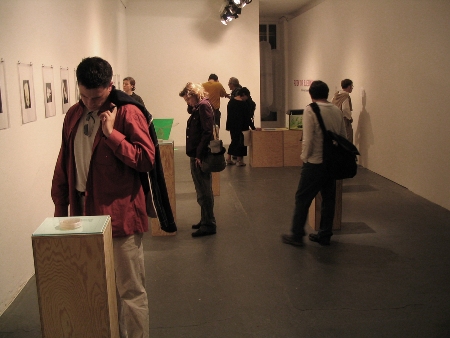
Germs Of Deception. NGBK, Berlin, 2005. In 1949, a US military group charged with biological research sent an agent to release Serratia marcescens (a harmless anthrax simulant) into the air ducts at the Pentagon. The mission was successful, and the results (complete contamination by the bacteria) were forwarded to the Pentagon. They neglected to mention that 100% germ coverage does not translate into 100% infection rate which does not translate into 100% mortality rate. Officials at the Pentagon became so panicked they immediately devoted generous amounts of resources to the research group. This con (or one like it) has been often used in the genesis of many of the world’s germ warfare programs. In Germs of Deception, CAE traces these cons, and recreates the misleading experiment in the gallery. According to our findings, NGBK is a suitable site for an anthrax attack, as the distribution rate was perfect. All our sensors lit up.
AMM: Much of your early work and number of your books address electronic or digital resistance. Net strikes, online and virtual activism are new forms of communications and performitivity. What is the philosophy behind your performances, and what are the goals of such actions?
CAE: One common thread in CAE’s work has been to show how the tools of oppression can be used for liberation. In the late 80s through the mid90s we were very interested in demonstrating how new information and communication technologies could be appropriated by resistant culture and used in ways for which they were never designed or intended. Currently, we are trying to show how the life sciences can be used for resistant purpose. This task is far more difficult as the level of alienation of people from these tools of production is much higher. People tend to be more skeptical and fearful of biotechnology, because unlike a computer, they are not very likely to interact with these technologies. At the same time, they see how much damage some of this technology is doing to the environment and to the social sphere. Many of our recent writings and projects have been designed to lower this level of alienation, and give people knowledge about and experience with the technology. We cannot let these powerful tools become the sole property of militaries and corporations.
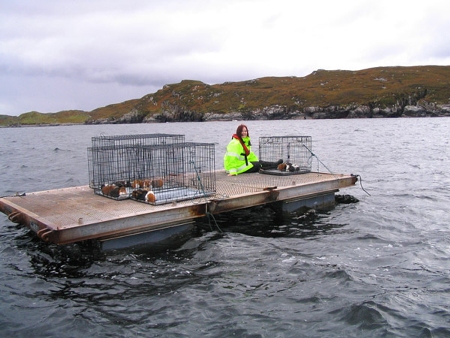
Marching Plague. In 1952-3, the British military conducted experiments off the Isle of Lewis to see if plague could be used as a tactical ship-to-ship weapon. The first test was to see if guinea pigs on a floatation platform could be hit from a mile away. To practice for the real release, a harmless bacteria, Bacillus subtilis, was substituted for plague. Using lines of smoke as the targeting system, the bacterial broth was launched from a pressurized atomizer off the back of the boat. Once the guinea pigs were retrieved, they were swabbed for traces of subtilis. On October 13, 2005, Critical Art Ensemble returned to the Isle of Lewis to recreate this experiment guided by the historical principle, the first time tragedy, the second time farce. Such is the history of germ warfare in general. It was tragic the first time until most efforts were halted after the Biological Weapons Convention of 1972, and farcical since the program’s reinvigoration after 9/11 (particularly by the Bush administration).
AMM: Are there previous theatrical and aesthetic models that influence the collective?
There are no early models that are exactly like us because we have had to adapt to a very different newly emerging technosphere, but there are a some with which we share some cultural DNA and that were influential on our way of thinking such as the San Francisco Diggers, Augusto Boal and Theater of the Oppressed, elements of the Living Theater, and some of the performance that emerged out of the Feminist Art Movement in the 70s.
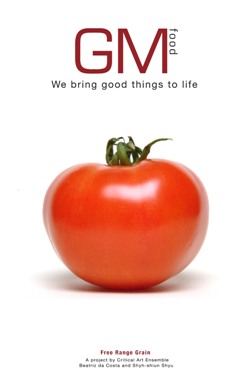
In general, the Diggers, the Situationists, and Provos were of great influence on us because they were among the first to realize that cultural action had causal value, and that no resistant (or they thought revolutionary) political movement could succeed without a cultural parallel. Certainly one of the historical high points of this type of modeling was in Italy in the late 70s, and hopefully we are at point where such a model can fully bloom for a global movement against neoliberal culture and economy.
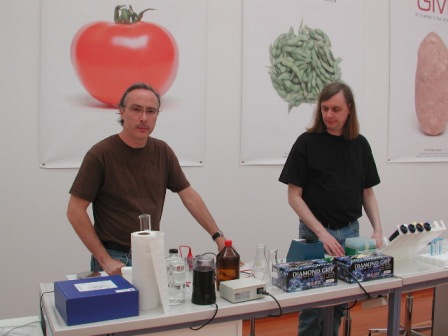
Free Range Grain is a live, performative action. CAE/da Costa/Shyu has constructed a portable, public lab to test foods for the more common genetic modifications. People bring us foods that they find suspect for whatever reason, and we test them over a 72-hour period to see if their suspicions are justified. While we will not be able to say conclusively that a given food is genetically modified (although we can offer strong probability as whether it is), we can test for conclusive negatives, and we can bring issues of food purity into the realm of public discourse. Identified contaminated food will be offered for consumption at your own risk. If on the other hand, if we find nothing, it lends credibility to the idea that the European food chain is safe from GM contaminants.
AMM: Your latest works are real examples of Science Theater (such as GenTerra or Free Range Grains) as well as your performances linked to contestational biology. The socio-political debate about genetic manipulation is maturing. But how can performance show specific aspects of the scientific research? Could you give some example from your work?
CAE: That is the beauty of quality web design. You can have a tremendous amount of information put into a digestible, entertaining package. The trick is to get participants to want to look at it. That means we have to convince them quickly they have a stake in the issue we are presenting. In projects like Free Range Grains or Molecular Invasion we can bring people into a larger discussion fairly easily because it has to do with food, and everyone has to eat. With a project like GenTerra, in which CAE is trying to discuss methods of risk assessment of genetically modified organisms the problem is more difficult. Here we had to create a minor “threat” by asking people to release genetically modified bacteria that we had engineered. The bacteria is completely harmless to the environment and to living things, but it sounds very frightening. People became very interested in risk assessment when they were faced with the decision of whether or not to release the bacteria.
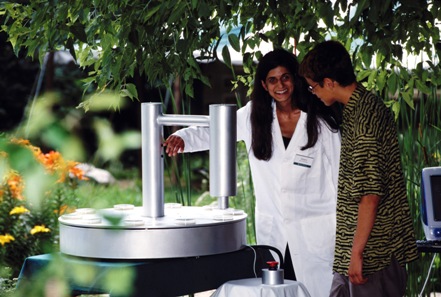
GenTerra, 2001, performance view, St. Norbert Art and Culture Center, Winnipeg, Manitoba, Canada. GenTerra was produced in collaboration with Beatriz da Costa; science consultant, Bob Ferrell; and robotics consultant, Garth Zeglin. GenTerra examines the relationship between the creation of genetically modified organisms (GMOs) and biological environmental resource management. Of particular interest was the means by which a popular method of risk assessment could be developed. Viewers of the website began the performative process by gathering information on GMOs. By using the performers and web-site as information resources, viewers were able to form more informed opinions on the dangers of GMO release, and were then given the opportunity to test this information.
AMM: CAE's mobile labs are supposedly designed to raise consciousness about the social problems regarding the environment, transgenics, reproductive technology and biological warfare. What do you hope people will come away with when they see one of your projects?
CAE: We hope for a few things: First, that the technology will be demystified; second, that a participant will have a more reasoned (rather than emotive) relationship to critical social issues regarding biotechnology; third, that through participatory experience, they will see the stake they have in a given issue both individually and socially; and finally, the experience will encourage them to become politically active in regard to given issue.
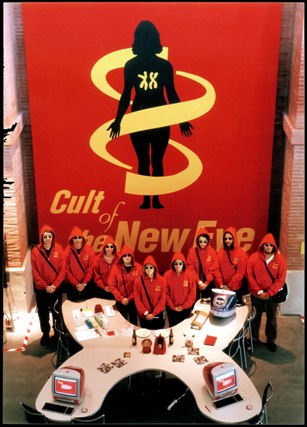
Cult of the New Eve, 1999.
AMM: What is the reaction of the public when you ask members to perform as “biologists” or as “human testers?” Do you use particular strategies of participation for these actions?
CAE: Most people don’t hesitate at all. The strategy is to perform in places where people go expecting to participate in an event. It can be a Natural History museum, a farmer’s market, or a local bar, just as long as people go to the place to do something and not just watch something.
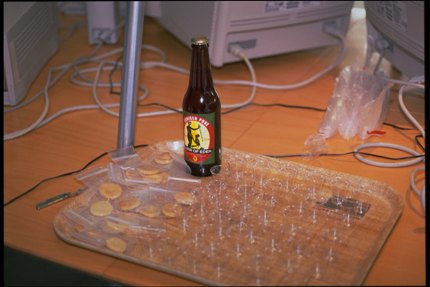
Cult of the New Eve, 1999 Transgenic beer and wafers for Cult communion.
AMM: Do new developments in the life sciences offer positive potential or pose greater threats? And also, how do you combine artistic, political, and scientific gestures in a performance?
CAE: Development in the life sciences cannot be stopped, but it can be guided. Whether a product or process is a threat or a blessing has to be examined on a case-by-case basis. There is no general position. The main problem is usually not knowledge or its product, but the way it is used within the current political-economy. Given the predatory nature of capitalism, almost anything can be a threat. The system is what needs to be changed, not the science.
Hybridization is an easy process since it is the permanent state of becoming that we are all a part of. All objects and processes have elements of science, politics and art in or associated with them. We just call attention to all the elements in various proportions that make up these mixtures, rather than ignoring some categories and favoring others.
AMM: You usually do your performances in museums or at festivals with themes involving the life sciences or digital media. Have you also been invited to theatre festivals? Do you think traditional theater is a retrograde form because it resists any hybridizing with technology?
CAE: We have been invited to theater festivals and conferences. Not many, but it has happened. At the events we have been at the presentations tend to be rather normalized, but I have found that event producers are willing to present just about anything we want once we have been invited. The theaters tend to have some of the best technology available for performance, it just that they don’t typically use it for radical ends and experiments. Theater in general is by no means technophobic.
AMM “The Drama Review” (edited by Richard Schechner) did a special section on Critical Art Ensemble: Do you see yourself as part of that anthropological, intercultural theatre that this journal usually covers?
CAE: No, that special issue happened because one of the associate editors, Rebecca Schneider, is a great supporter of CAE’s work, and insisted the issue should be done.
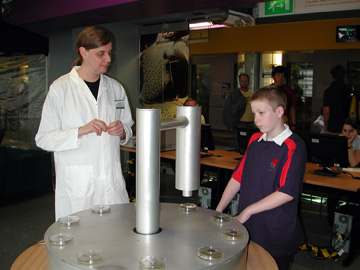
Steve Kurtz.
AMM: You have been accused of being a “bioterrorist”. Could you say something about that tragic event?
CAE: Steve’s ordeal was one of many tragedies suffered as a result of the policies of the neoconservatives and the burgeoning US security state post-911, including the policy of “preventive justice” at the Department of Justice.
On May 11, 2004, Steve’s wife of 20 years and CAE member, Hope, died of heart failure in their home in Buffalo. Steve called 911. Buffalo Police who responded along with emergency workers became alarmed by the presence of art materials in their home that had been displayed in museums and galleries throughout Europe and North America. Convinced that these materials — which consisted of several petri dishes containing harmless forms of bacteria, and scientific equipment for testing genetically altered food — were the work of a terrorist, the police called the FBI.
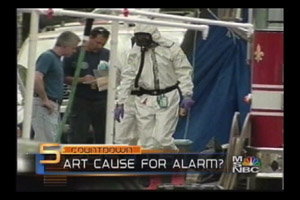
The next day, as Steve was on his way to the funeral home, he was stopped and illegally detained for 22 hours by agents from the FBI and Joint Terrorism Task Force, who informed him he was being investigated for “bioterrorism”.
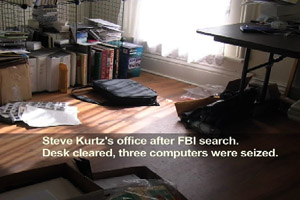
Meanwhile, agents from numerous federal law enforcement agencies descended on Steve’s home in Hazmat suits. Cordoning off half a block around his home, they seized his cat, car, computers, manuscripts, books, equipment, and even his wife's body from the county coroner. A week later, only after the Commissioner of Public Health for New York State had tested samples from the home and announced there was no public safety threat, was he allowed to return to his home and to recover Hope’s body.

Today he and long-time CAE collaborater Robert Ferrell (former Chair of the Department of Genetics at the University of Pittsburgh Graduate School of Public Health) face trumped-up charges of "mail fraud" and "wire fraud" – which, thanks to the USA PATRIOT Act, now carry a possible 20 year sentence – the same as the original “bioterrorism” charges would have.
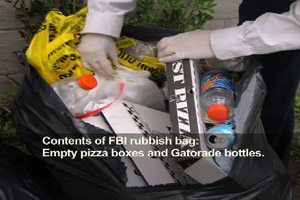
The case threatens to set very dangerous precedent by eroding the boundary between civil and criminal law and by criminalizing those who criticize government policy. If the Justice Department wins this case, it will double the federal government’s power overnight. The case has already led to dispossession of the public's fundamental right to scientific knowledge. Because of this case, many of the manufacturers that formerly supplied amateurs and science hobbyists no longer will for fear of litigation. The case therefore threatens to end independent research and seriously damage the public's ability to critique corporations and the military, which will exercise even more exclusive control of scientific knowledge.
(For more information about the case, as well as how you can help, please go to www.caedefensefund.org).
AMM: What are other groups are working in a similar way to you in the USA and in Europe.
CAE: There aren’t many groups working in science-theater that we know of. subRosa is one of the few. However, there are many groups working in tactical media world-wide — Institute for Applied Autonomy, The Yes Men, Carbon Defense League, Finishing School, Temporary Services, Preemptive Media Collective, My Dad’s Strip Club, Space Hijackers, Conglomco.org, irational.org, Bureau of Inverse technology, and on and on.
AMM: Have you come to Italy to introduce your work, and have you any received any invitations for the future?
CAE: We are written about in Italian magazines, journals and other publications, and most of our books have been translated into Italian, but, unfortunately, CAE has never been asked to do a project in Italy.
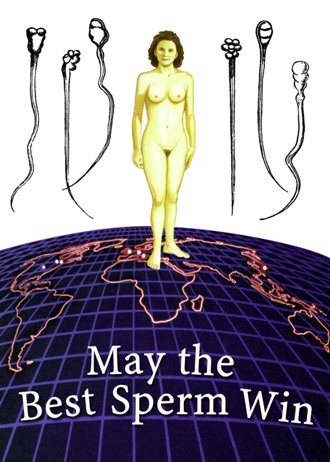
|
© copyright ateatro 2001, 2010
|
Se cerchi (e se vuoi comprare) su ibs un libro o un autore di cui si parla in questa pagina
|
|
|
|
|

